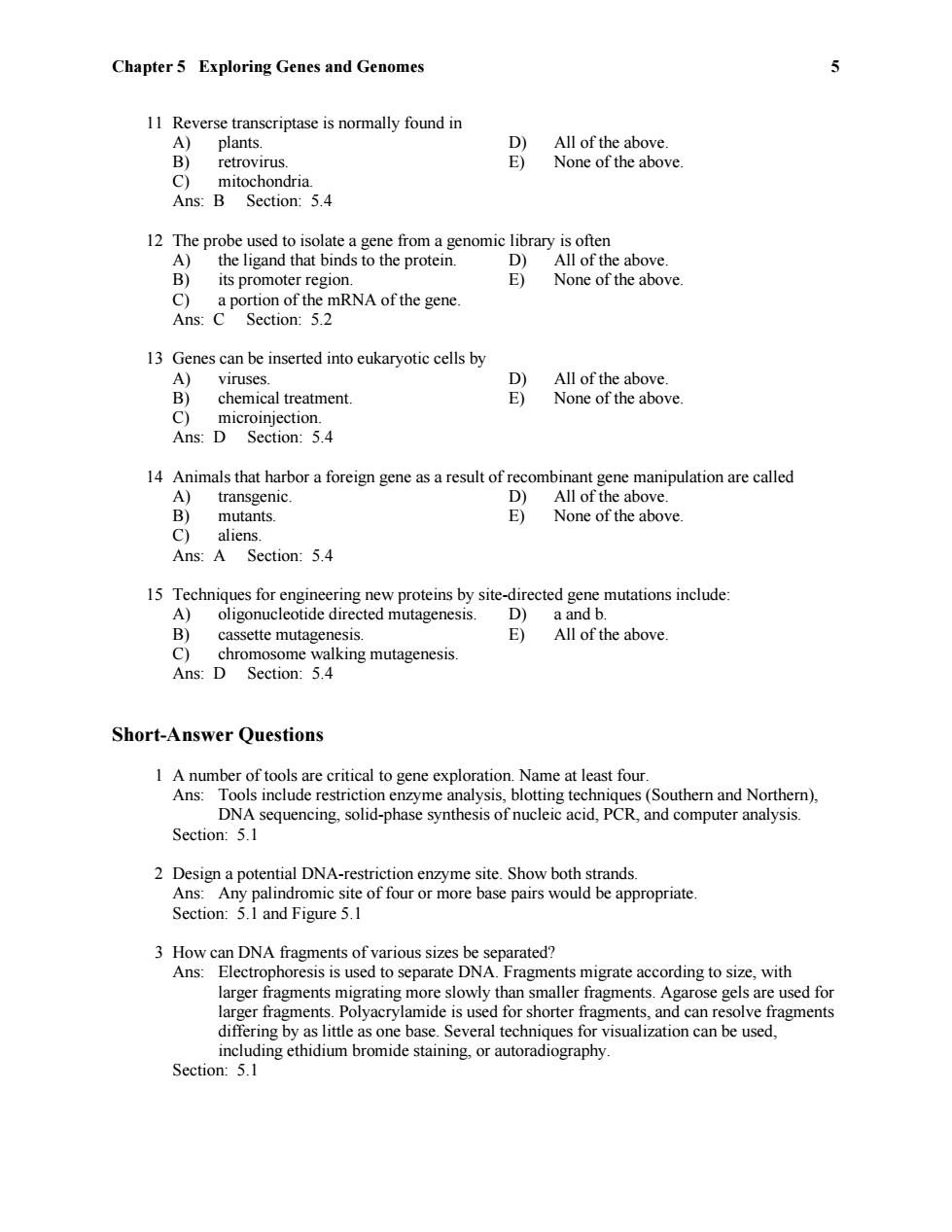正在加载图片...

Chapter 5 Exploring Genes and Genomes 11 Reverse transcriptase is normally found in A) plants. D) All of the above. B) retrovirus. E) None of the above. c) mitochondria. Ans:B Section:5.4 12 The probe used to isolate a gene from a genomic library is often A)the ligand that binds to the protein. D) All of the above. B) its promoter region. E) None of the above. C)a portion of the mRNA of the gene. Ans:C Section:5.2 13 Genes can be inserted into eukaryotic cells by A)viruses. D) All of the above. B) chemical treatment. E) None of the above. C) microinjection. Ans:D Section:5.4 14 Animals that harbor a foreign gene as a result of recombinant gene manipulation are called A) transgenic. D) All of the above. B) mutants E) None of the above. C)aliens Ans:A Section:5.4 15 Techniques for engineering new proteins by site-directed gene mutations include: A) oligonucleotide directed mutagenesis.D) a and b. B) cassette mutagenesis. E)All of the above. C) chromosome walking mutagenesis. Ans:D Section:5.4 Short-Answer Questions 1 A number of tools are critical to gene exploration.Name at least four. Ans:Tools include restriction enzyme analysis,blotting techniques(Southern and Northern), DNA sequencing,solid-phase synthesis of nucleic acid,PCR,and computer analysis. Section:5.1 2 Design a potential DNA-restriction enzyme site.Show both strands. Ans:Any palindromic site of four or more base pairs would be appropriate. Section:5.1 and Figure 5.1 3 How can DNA fragments of various sizes be separated? Ans:Electrophoresis is used to separate DNA.Fragments migrate according to size,with larger fragments migrating more slowly than smaller fragments.Agarose gels are used for larger fragments.Polyacrylamide is used for shorter fragments,and can resolve fragments differing by as little as one base.Several techniques for visualization can be used, including ethidium bromide staining,or autoradiography. Section:5.1Chapter 5 Exploring Genes and Genomes 5 11 Reverse transcriptase is normally found in A) plants. D) All of the above. B) retrovirus. E) None of the above. C) mitochondria. Ans: B Section: 5.4 12 The probe used to isolate a gene from a genomic library is often A) the ligand that binds to the protein. D) All of the above. B) its promoter region. E) None of the above. C) a portion of the mRNA of the gene. Ans: C Section: 5.2 13 Genes can be inserted into eukaryotic cells by A) viruses. D) All of the above. B) chemical treatment. E) None of the above. C) microinjection. Ans: D Section: 5.4 14 Animals that harbor a foreign gene as a result of recombinant gene manipulation are called A) transgenic. D) All of the above. B) mutants. E) None of the above. C) aliens. Ans: A Section: 5.4 15 Techniques for engineering new proteins by site-directed gene mutations include: A) oligonucleotide directed mutagenesis. D) a and b. B) cassette mutagenesis. E) All of the above. C) chromosome walking mutagenesis. Ans: D Section: 5.4 Short-Answer Questions 1 A number of tools are critical to gene exploration. Name at least four. Ans: Tools include restriction enzyme analysis, blotting techniques (Southern and Northern), DNA sequencing, solid-phase synthesis of nucleic acid, PCR, and computer analysis. Section: 5.1 2 Design a potential DNA-restriction enzyme site. Show both strands. Ans: Any palindromic site of four or more base pairs would be appropriate. Section: 5.1 and Figure 5.1 3 How can DNA fragments of various sizes be separated? Ans: Electrophoresis is used to separate DNA. Fragments migrate according to size, with larger fragments migrating more slowly than smaller fragments. Agarose gels are used for larger fragments. Polyacrylamide is used for shorter fragments, and can resolve fragments differing by as little as one base. Several techniques for visualization can be used, including ethidium bromide staining, or autoradiography. Section: 5.1